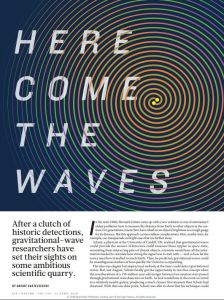Join getAbstract to access the summary!

Join getAbstract to access the summary!
Davide Castelvecchi
Here Come the Waves
After a clutch of historic detections, gravitational wave researchers have set their sights on some ambitious scientific quarry.
Nature, 2018
What's inside?
Gravitational waves offer the latest tests for Albert Einstein’s theories of General Relativity.
Recommendation
An entirely new field of observational astronomy was inaugurated with the operation of gravitational wave observatories in the United States in 2015 and Italy in 2017. Until recently, gravitational forces could only be inferred from the distribution and motion of astronomical objects, but now a new window is opening up on the structure of the universe. Davide Castelvecchi’s overview of the achievements of gravitational wave astronomy to date and its future development is an exciting and approachable introduction to a fascinating new frontier.
Summary
About the Author
Davide Castelvecchi is a staff reporter for Nature. He trained as a mathematician, received a doctorate from Stanford University and did post-doctoral work at the University of Paris-Sud at Orsay.



















Comment on this summary